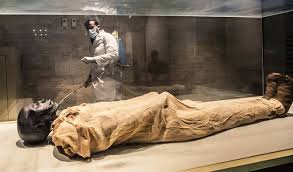The mummified remains of King Thutmose IV

Grafton Elliot Smith (1871-1937), upon examining the body of the king, concluded that the king was very ill at the time of death and had seemingly suffered with an illness for a while, sadly describing Thutmose IV as “extremely emaciated”.
Many decades later in 2012, the Imperial College London examined the body of the late king, and along with knowledge of some of Thutmose’s family dying young (such as his great-grandson Tutankhamun and his two still born daughters), the surgeon examining the king theorized that Thutmose and other members of the family may have possibly suffered with Temporal lobe epilepsy.
Some scholars think that this idea could explain the king’s famous Dream Stela, where he describes the Sphinx of Giza as talking to him, as those with Temporal lobe epilepsy do suffer with visions. This idea however is a theory at the present and is not an ultimate conclusion. And it must be noted that the reason for the dream stela could have been propagandist, or simply Thutmose certifying his status as a divine ruler…such as Hatshepsut’s writing of her divine birth at Deir el-Bahari. Or… it could have been something the king truly believed occurred to him, without the modern idea that he had an illness causing such a thing.
The king’s body measures at 1.64m (5 ft 4.8 in), however, due to his disembodied feet, he was likely taller in life. He was relatively young, with Smith putting his age at death at approximately 28, although more modern scholars suggest mid 30s, perhaps. He has both ears pierced and what appears to be a smile with teeth showing. Most notable is his hair, which is entirely natural, long and parted in the middle, the colour is reddish brown.
Hits: 7






